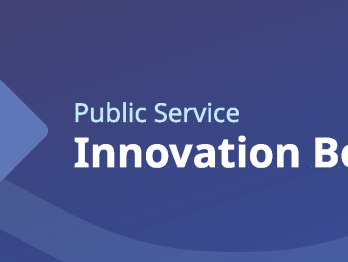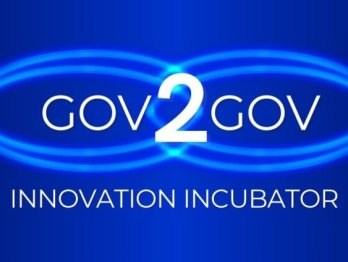Remixing the Mission Design Canvas

Missions offer a formalised path to creating public value but urgently need more experimental and iterative approaches to make missions a reality in the messy world of public policy. Mission-oriented innovation needs not only an ambitious clarity of purpose but also the alignment of system-level operational and governance mechanisms. OPSI is remixing some of its systems tools to help with that and have redesigned a tool to specifically address the connection between the ambition and implementation of missions and we want your feedback.
Driven heavily by the United Nations Sustainable Development Goals, Horizon Europe’s 2021-27 programme, the work of the University College London’s Institute for Innovation and Public Purpose (including the Mission-Oriented Innovation Network), and other efforts, mission-oriented innovation has become a focus for myriad governments around the world. A proliferation of mission-oriented policies have followed. However, as noted at our recent Mission Oriented Innovation Bootcamp, hosted with UCL-IIPP, missions also need new tools, new approaches, and new capabilities to deliver on their grand promises. OPSI, as part of its Horizon 2020 work programme, is developing such support for mission-oriented innovation as part of its theoretical work on the purposes of public sector innovation.
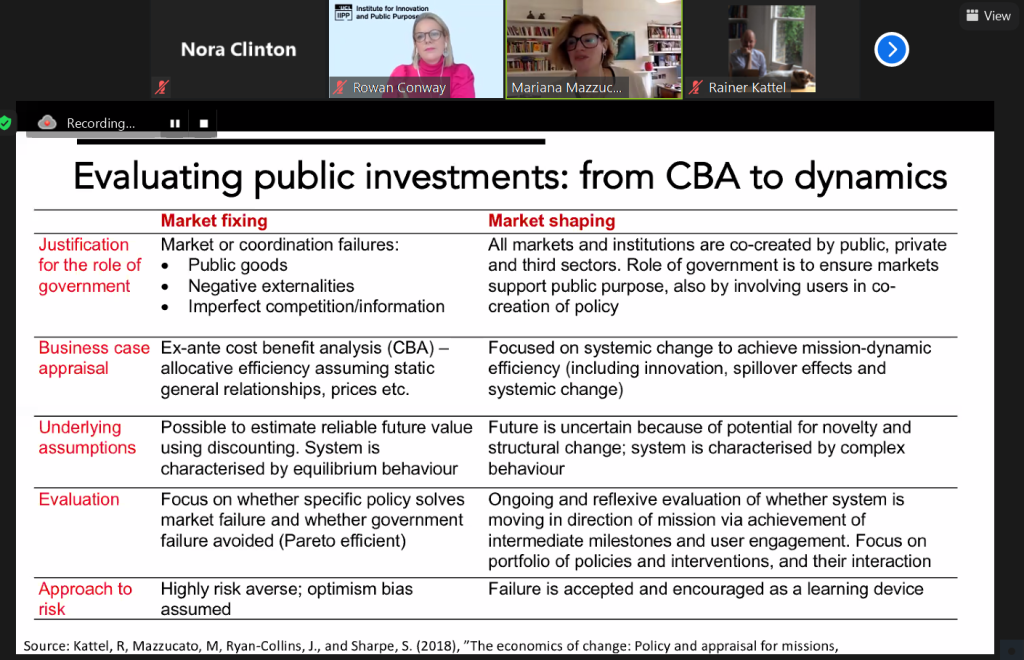
Mission-oriented innovation requires not only the ambition to solve a societal challenge, but also a path to get there—including not only the system-wide clarity of purpose but also the operational alignment around that purpose. They need strong narratives, feedback loops, short and long-term evaluation, new partnership models, supportive procurement policies, public and private networks, new funding and budget models, collaboration support platforms…and the list goes on.
Context matters
The mix of policies, strategies, and actions needed to support missions varies widely across contexts. The way in which a similar food security mission is tackled will depend not only on cross-border procurement rules and supply chains, but also on the local capacities of public and private sector stakeholders to build consensus and work in new ways. The bad news is that there is no magic recipe for mission-oriented innovation success. However, the good news is that we are trying to identify the key questions and components relevant for all missions, regardless of their sector or context.
Introducing the Mission Design Canvas
OPSI is remixing a tool we developed for mission planning—for turning a set mission into a dynamic implementation strategy. In 2019, OPSI was in Estonia building capacity with the country’s Deputy Secretary Generals for mission-oriented innovation and systems approaches. Officials at this senior level within governments, while not always involved in setting missions, are often the key to translating ministerial and political priorities into action. In the years of work at OPSI following public sector innovation work inside of governments, I have realised that, indeed, this translation is where good ideas sink or swim.
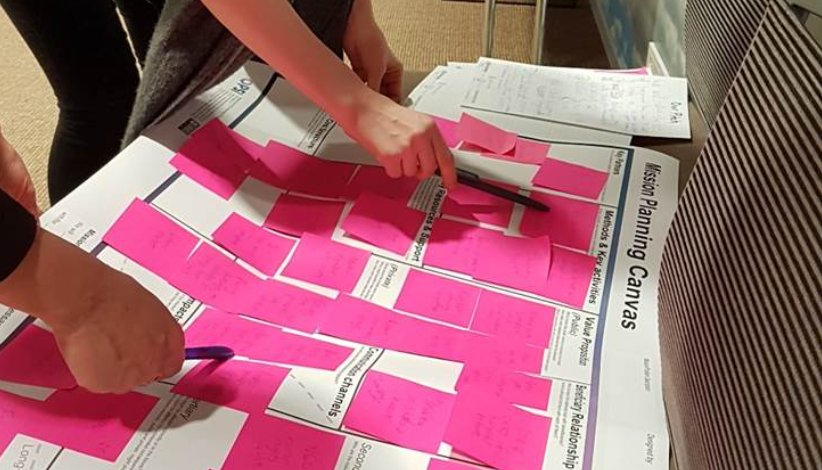
The Mission Planning Canvas, based on the often-remixed original design tool the Business Model Canvas, was used in Estonia as a bespoke tool for Estonian DSGs. Following lessons from last month’s Mission-Oriented Innovation Bootcamp, we at OPSI have remixed it.
The revised Mission Design Canvas is not a detailed roadmap of actions for carrying out mission-oriented innovation projects, but contains key components or “jobs to be done” in transitioning from mission-setting to mission-governance and action. This is not meant to capture all of the necessary work—there is no canvas big enough for that level of nuance. However, we hope this canvas represents a reusable pattern for use across contexts that captures some of the key components of mission governance and implementation. Those setting out on accomplishing missions need not address all of these at once either; each area is an adventure on its own. One of the goals of this canvas is to lay out most of the pieces of a mission to see how everything fits together and to test different iterations of mission governance—when one piece is changed, the impacts on other areas can also be identified, adapted, or reworked.
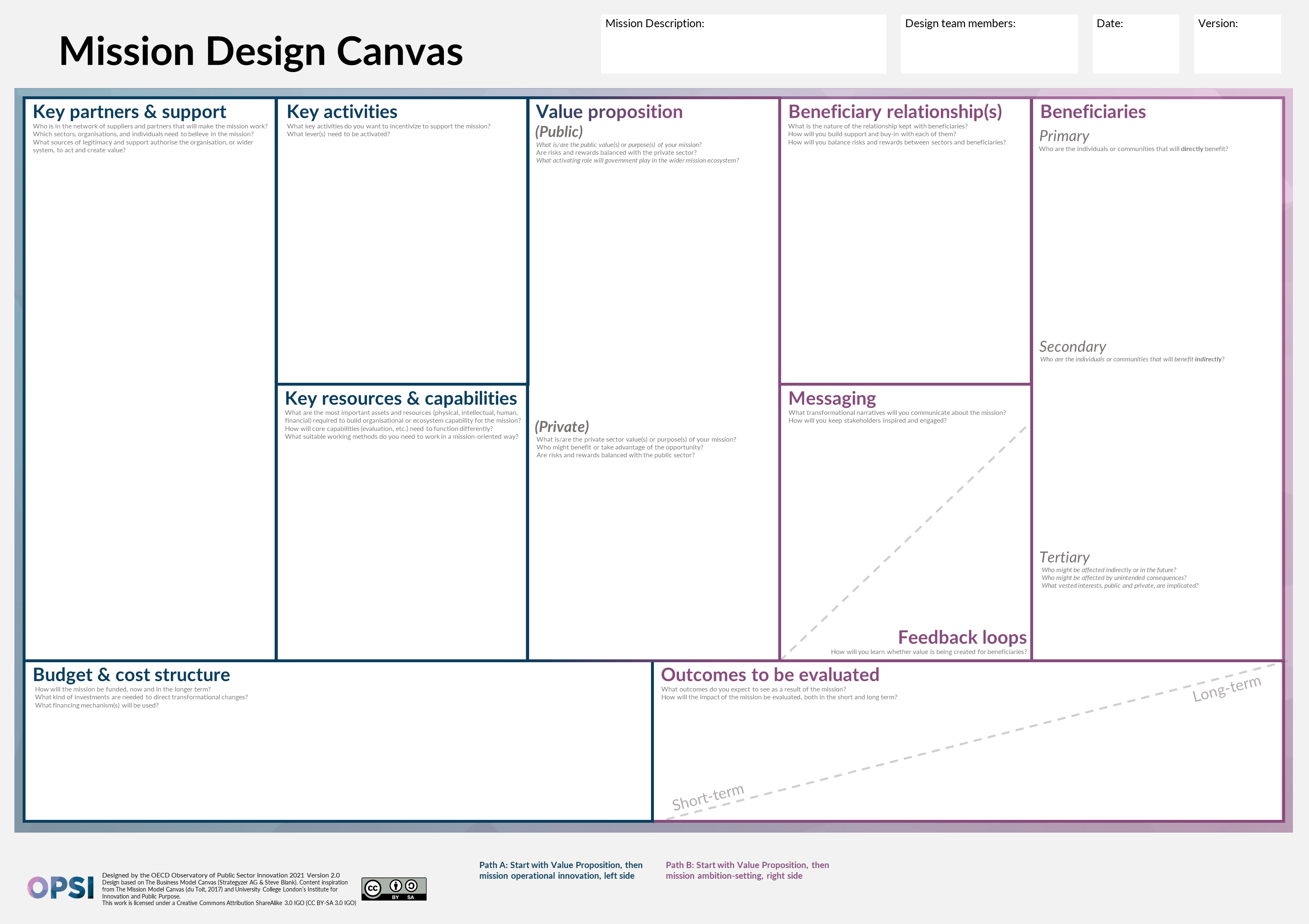
How to use the Mission Design Canvas
Regardless of the mission or context, the first place to start is Value Proposition. If there is not broad consensus on this, it should be the first thing sorted out. The Value Proposition asks users to define both the public and private value proposition, echoing Mariana Mazzucato’s insistence on value creation. This should be an activity that re-affirms and builds consensus around a set mission. It can also be used to set missions, but there are more focused tools for that.
In general, the boxes on the right side of the canvas address the ambition and purpose of the mission. Again, for missions that have been set, this may already be well documented and in this case will be a refresher to build consensus. Value proposition is closely linked to Beneficiaries, primary, secondary, and tertiary. Between Value proposition and Beneficiaries, messaging, feedback loops, and beneficiary relationships are defined since these may vary by beneficiary. When using the canvas, you may choose to use colours to indicate specific relationships.
The boxes on left side of the canvas include the components of operational mission governance that define what missions look like on the ground, when ambitions are combined with organisational realities. Again, this side can also be used to lay out the current realities and also identify areas for policy or organisational innovation, such as changes in procurement policies or talent recruitment strategies.
Alternately, you can start wherever makes the most sense to you according to your mission. We hope you will tell us how you used it and which areas you found most helpful.
Try it out
All of OPSI’s tools are works in progress, improved by what we learn from applying it in practice. To that end, we ask you to try out the Mission Design Canvas and tell us what was helpful, what is missing, and what guidance you would want when using this in your own context. We will take this feedback into account in redesigning the next version of the canvas, which we will use in our upcoming mission-oriented innovation work.
Once we make sure we have the right areas in the canvas, we will develop specific tools for each area and guidance for using them.
The canvas is available as a printable canvas poster. Because collaboration these days tends to be done virtually, here is also and editable digital whiteboard Mural template of the canvas at the bottom of this post.
Finally, this tool, like many in the OPSI Toolkit Navigator is licensed for adaptation, so if you wish to remix it on your own, feel free to do so with attribution.
Please share your thoughts about the canvas and any of our mission-oriented innovation work by commenting below or emailing us.
OPSI and UCL-IIPP are also interested in hearing from the mission-oriented innovation practices being tested in organisations around the globe. If you are interested in sharing your experiences or feature as a case study in our research, please let us know.
Watch the 2020 Mission-Oriented Innovation Bootcamp on YouTube replay
 Mission Design Canvas Template by MURAL
Mission Design Canvas Template by MURAL
Open to create a mural from this template in your workspace.



